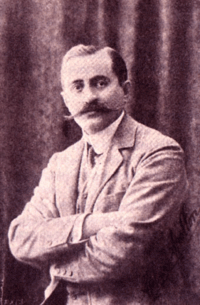Behaeddin Shakir

Behaeddin Shakir or Bahaeddin Shakir (Ottoman Turkish: بهاءالدین شاکر, Modern Turkish: Bahaettin Şakir; 1874, Istanbul – April 17, 1922) was a founding member of the Committee of Union and Progress (CUP). At the end of World War I, he was detained with other members of the CUP, first by the local Ottoman court martial and then by the British government. He was then sent to Malta pending military trials for crimes against humanity, which never materialized, and was subsequently exchanged by the British for hostages held by Turkish forces.
Armenian–Azerbaijani War
The Armenian Revolutionary Federation (ARF) blamed Behaeddin Shakir for involvement in the Armenian–Azerbaijani War, specifically in the communications between the Azerbaijani political party Musavat and the CUP. In the initial stages of this war, the ARF (Armenian Militia) was engaged in armed confrontation with the Azerbaijani forces during which many Muslims were expelled from Baku or went underground. The tide turned when Enver Pasha of the Ottoman Empire begin to move forward with the newly established Army of Islam. British Major General Lionel Dunsterville ordered the evacuation of the city on September 14, after six weeks of occupation, and withdrew to Iran; most of the Armenian population escaped with the British forces. The Army of Islam and their Azerbaijani allies, led by Nuri Pasha, entered Baku on September 15. However, after the Armistice of Mudros between Great Britain and the Ottoman Empire on October 30, Turkish troops were substituted for those of the Triple Entente. Headed by British general William Thomson, who had declared himself the military governor of Baku, 5,000 Commonwealth soldiers arrived in Baku on November 17, 1918. By General Thomson's order, martial law was implemented in Baku.
Armenian Genocide
Behaeddin Shakir was claimed to be the central figure of the Teşkilat-i Mahsusa (Special Organization).[1] This is sometimes used as proof of a state organized genocide using the tehcir (deportations) process of the Tehcir law. Halil Berktay says that local administrators objected to Behaeddin Shakir's deportation orders and called for his arrest.[2] Dissidents were usually replaced by hardliners; sometimes twice if the replacement was not pliant.[3]
In the autumn of 1919, the Armenian Revolutionary Federation (ARF), part of the Armenian national liberation movement, ruled to punish the executors of the Armenian Genocide. Under Operation Nemesis, Aram Yerganian and Arshavir Shirakian were given the task to assassinate both Cemal Azmi and Shakir who were in Berlin. On April 17, 1922, Shirakian and Yerganian encountered Azmi and Shakir who were walking with their families at the Uhlandstrasse street.[4] Shirakian managed to kill only Azmi and wound Shakir. Yerganian immediately ran after Shakir and killed him with a shot to his head.[5][6] The assassins were never detained.
References
- ↑ Robert Kaplan (July 7, 2007). "Long history of the doctors of doom". Sydney Morning Herald. Retrieved 2008-09-03.
- ↑ Düzel, Neşe (2000-10-09). "Ermenileri özel örgüt öldürdü". Radikal (in Turkish). Retrieved 2008-09-03.
Osmanlı ordusu ve bürokrasisinin de bunun korkunç bir olay olduğunu algıladığını, bunları valilerden ve garnizon komutanlarından bağımsız olarak fütursuzca yapmış olan özel timlerden iğrendiğini ve hatta Enver ve Talat'ın özel adamı olan Behaeddin Shakir hakkında 1915-16 yıllarında tevkif müzekkeresi çıkaran, onu tutuklamaya çalışan valiler ve garnizon komutanlarının olduğunu görüyoruz.
- ↑ Mann, Michael (2005). The Dark Side of Democracy: Explaining Ethnic Cleansing. Cambridge University Press. p. 159.
- ↑ "Two 'Young Turks' Murdered in Berlin" (PDF). New York Times. April 19, 1922. Retrieved 25 May 2013.
- ↑ Berberyan, Nazaret (April 13, 2010). ՏԱՐԵԴԱՐՁՆԵՐ- Արշաւիր Շիրակեան Հայ ժողովուրդի Արդարահատոյց Բազուկը. Asbarez (in Armenian). Retrieved 25 May 2013.
- ↑ Derogy, Jacques (1990). Resistance and revenge: the Armenian assassination of the Turkish leaders responsible for the 1915 massacres and deportations. Transaction Publishers. p. 61. ISBN 9781412833165.